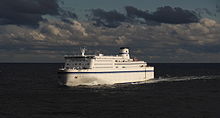 The Ishikari under the Meiko Nishi Ohashi bridges The Ishikari under the Meiko Nishi Ohashi bridges | |
| Locale | Japan |
|---|---|
| Transit type | Cruiseferry |
| Began operation | October 20, 1970 (1970-10-20) |
| No. of lines | 1 |
| No. of vessels | 3 |
| No. of terminals | 3 |
| Website | taiheiyo-ferry |
The Taiheiyō Ferry (太平洋フェリー, Taiheiyō-Ferii, literally Pacific Ferry) is a privately-owned cruiseferry operator connecting Nagoya, Sendai, and Tomakomai in Japan. It is a subsidiary of the Nagoya-based Meitetsu Group, a group of companies that focuses primarily on rail transport in the Chūkyō metropolitan area.
History
The Taiheiyō Ferry was first founded as the Taiheiyō Enkai Ferry (太平洋沿海フェリー, Pacific Coastal Ferry) in 1970, operating a line between Nagoya and Ōita City with the Arkas, with a stop at Nachikatsuura, Wakayama added in May 3rd, 1975. The current route between Nagoya, Sendai, and Tomakomai soon began in 1973.
In 1982, the Meitetsu Group acquired the Taiheiyō Enkai Ferry and renamed it to its current name.
Routes
The Taiheiyō Ferry operates a single regular route between Nagoya, Sendai, and Tomakomai. Ships operate every day between Sendai and Tomakomai, and every other day between Nagoya and Sendai. Out of the three ships the company operates, only the Kiso and Ishikari stop at Nagoya. The company also operates seasonal routes to Ise Bay, Kōchi, Okinawa, and the Bonin Islands.
Fleet
Current fleet
The Taiheiyō Ferry has operated a total of twelve ships, three of which are in operation: the Kiso, Ishikari, and Kitakami, which are named after the Kiso, Ishikari, and Kitakami rivers, respectively. The names are chosen to represent each region (Chūbu, Hokkaido, and Tōhoku) that the ferry serves.
All ships can carry a certain number of cars as well as passengers. Additionally, all ships are equipped with dining rooms and rooms for lodging.
| Ship | Built | Builder | Gross Tonage | Length | Width | Passengers | Vehicles | Image |
|---|---|---|---|---|---|---|---|---|
| Kiso (2nd generation) | July 2004 | Mitsubishi Heavy Industries Shimonoseki Shipyard |
15,795 tons | 199.9 m | 27.0 m | 800 people | 113 passenger cars 188 trucks |
 |
| Ishikari (3rd generation) | March 2011 | Mitsubishi Heavy Industries Shimonoseki Shipyard |
15,762 tons | 199.9 m | 27.0 m | 783 people | 100 passenger cars 189 trucks |
 |
| Kitakami (2nd generation) | January 2019 | Mitsubishi Heavy Industries Shimonoseki Shipyard |
13,694 tons | 192.5 m | 27.0 m | 535 people | 146 passenger cars 166 trucks |
Former fleet
| Ship | Builder | Entered service | Left service | Notes |
|---|---|---|---|---|
| Arkas | Setoda Shipyard | 1972 | 1987 | Sold to Strintzis Lines |
| Albireo | Setoda Shipyard | 1973 | 1989 | Sold to Strintzis Lines |
| Alnasl | NHI Corporation Toyama Shipyard |
1973 | 1975 | Sold to Nihon Car Ferry |
| Argo | NHI Corporation Toyama Shipyard |
1973 | 1980 | Sold to Kansai Kisen |
| Ishikari (1st generation) | Naikai Zosen Corporation Setoda Shipyard |
1975 | 1991 | Sold to Strintzis Lines |
| Daisetsu | Naikai Zosen Corporation Setoda Shipyard |
1975 | 1985 | Sold to Higashi Nihon Ferry |
| Kiso (1st generation) | Mitsubishi Heavy Industries Shimonoseki Shipyard |
1987 | 2004 | Sold to Hellenic Seaways |
| Ishikari (2nd generation) | Mitsubishi Heavy Industries Kobe Shipyard |
1989 | 2011 | Sold to Golden Spring Enterprise |
| Kitakami (1st generation) | Mitsubishi Heavy Industries Shimonoseki Shipyard |
1989 | 2019 | Scrapped |
Incidents
During the 2011 Tōhoku earthquake, the Kitakami (1st generation) was moored at Sendai. The Kitakami managed to escape to sea before the ensuing tsunami, but Taiheiyō Ferry's terminal was heavily damaged along with the rest of the Port of Sendai. 123 cars belonging to the company and most of the equipment on shore were lost. Regular services to Sendai resumed on June 5, and repairs to the terminal building were completed on July 8.
See also
References
- "8:太平洋フェリー/苫小牧-仙台-名古屋航路、今後も3隻体制維持。社内外でのコスト削減進める" [8.Taiheiyō Ferry/ Tomakomai - Sendai - Nagoya route continue maintain 3 fleets , promote cost reduction inside and outside the company] (in Japanese). Japan Maritime Daily. February 13, 2002. Retrieved November 12, 2019.
- ^ "「いしかり」で行く北海道航路、充実の船内でデイクルーズ" [Sailing to the Hokkaido route by "Ishikari" , Day cruise in fulfilling shipboard]. Web Cruise (in Japanese). Kaiji Press. p. 3.
- "会社沿革" [Corporate history]. Taiheiyō Ferry (in Japanese). Retrieved November 12, 2019.
- "運航日程表 2019年12月~2020年3月まで" [Sailing schedule December 2019 - March 2020] (PDF). Taiheiyō Ferry (in Japanese). Retrieved November 13, 2019.
- "KISO(きそ) 詳細データ" [KISO detailed data]. www.nmri.go.jp. Retrieved 2019-11-13.
- 国内最大クラス クルーズフェリー 新 "いしかり"の紹介 [Introduction of Japan's largest class cruise ferry new "Ishikari"]. Vol. 47. Journal of the JIME. p. 2.
- "三菱造船 下関で太平洋フェリー向け大型フェリーの命名・進水式を実施名古屋~仙台~苫小牧定期航路に就航する新「きたかみ」" [Mitsubishi Shipbuilding hold christening & launching ceremony at Shimonoseki ship yard, New "Kitakami" put in to Nagoya - Sendai - Tomakomai route]. プレスリリース・ニュースリリース配信シェアNo.1|PR TIMES. Retrieved 2019-11-13.
- "船舶紹介|太平洋フェリー". www.taiheiyo-ferry.co.jp. Retrieved 2019-11-13.
- "船舶紹介" [Fleet Information]. www.taiheiyo-ferry.co.jp. Retrieved 2019-11-13.
- 川尻稔 (2011). "仙台港での地震津波遭遇状況報告 3 月 11 日その瞬間". 津波に遭遇した船の行動事例集 [Tsunami encountered ships action cases] (PDF) (in Japanese). Ministry of Land, Infrastructure, Transport and Tourism. p. 50. Retrieved November 13, 2019.
External links
 Media related to Category:Taiheiyo Ferry at Wikimedia Commons
Media related to Category:Taiheiyo Ferry at Wikimedia Commons